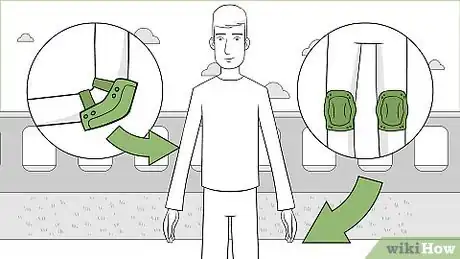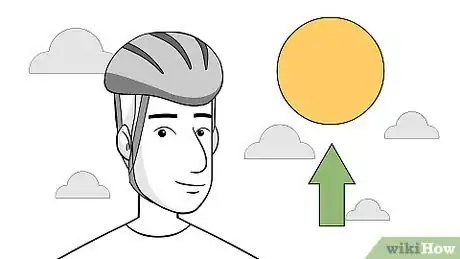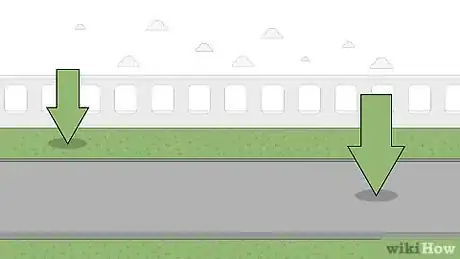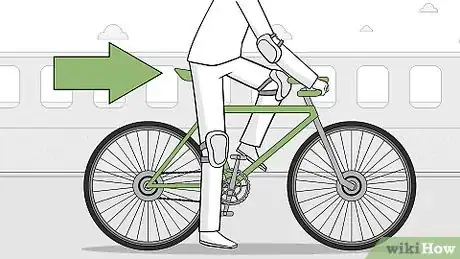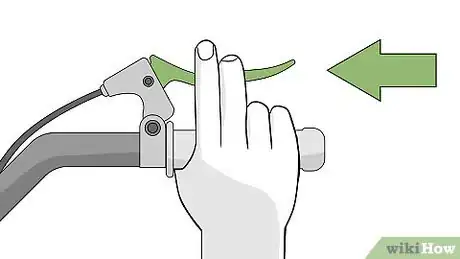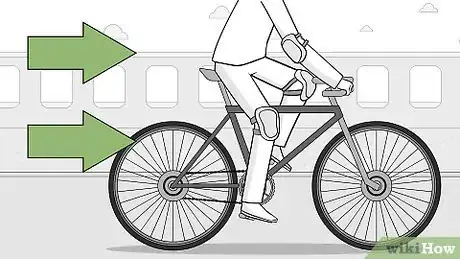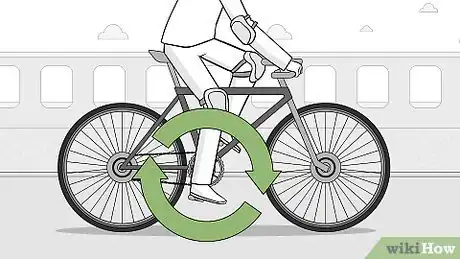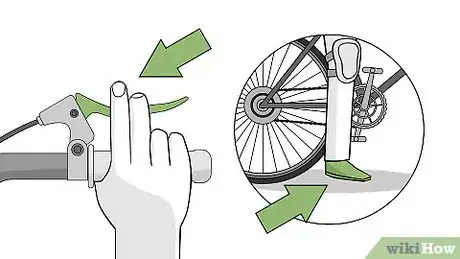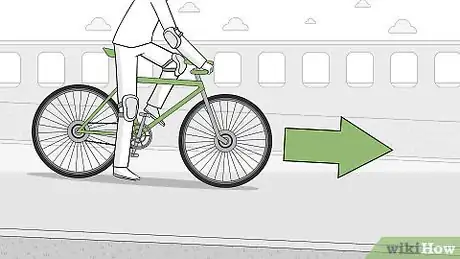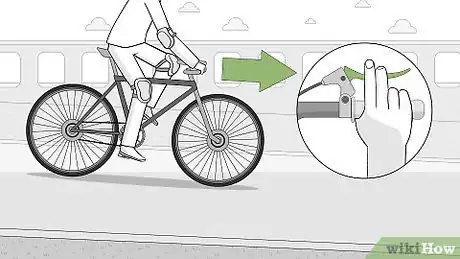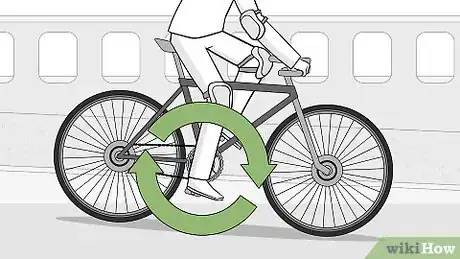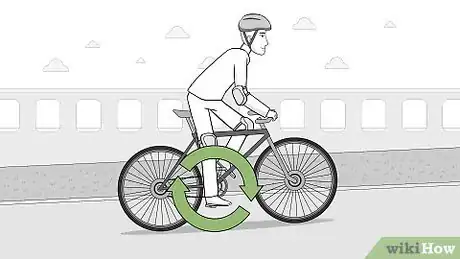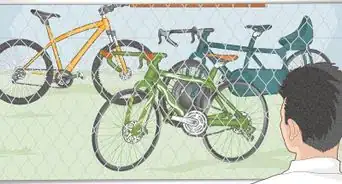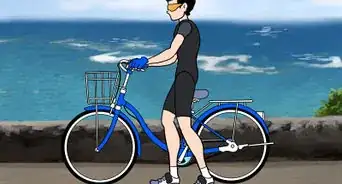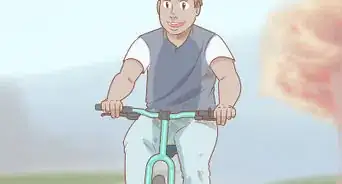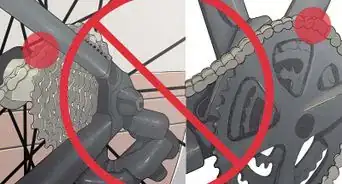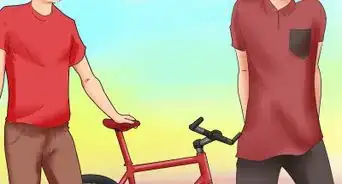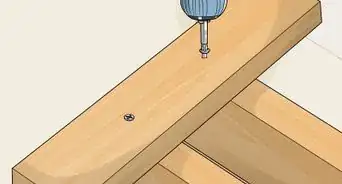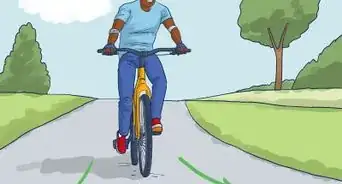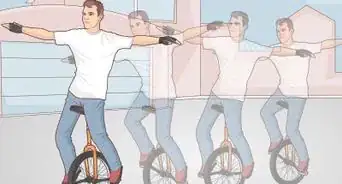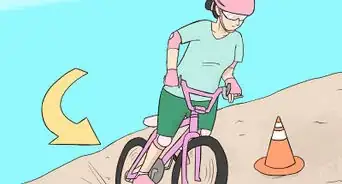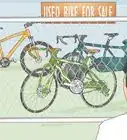This article was co-authored by Jonas Jackel. Jonas Jackel is the Owner of Huckleberry Bicycles, a bicycle retail store based in San Francisco, California. Jonas has over 20 years of experience managing bicycle retail stores and has operated Huckleberry Bicycles since 2011. Huckleberry Bicycles specializes in servicing, repairing, and custom building road, cross, gravel, touring, folding, and e-bikes. Jonas was also previously sat on the Board of Directors for Bike East Bay, a bicycle-advocacy non-profit organization based in Oakland, California.
There are 16 references cited in this article, which can be found at the bottom of the page.
wikiHow marks an article as reader-approved once it receives enough positive feedback. This article has 30 testimonials from our readers, earning it our reader-approved status.
This article has been viewed 1,950,053 times.
Do you want to go outside and ride a bike? Are you trying to teach someone else? Many adults never got the chance to learn how to ride a bike and many kids want to learn. There’s no reason to be embarrassed. Instead, get eager to start one of the healthiest, most environmentally friendly, and most satisfying forms of self-transportation possible. It requires preparation, technique, and a little falling, but anyone can learn how to ride a bicycle.
Things You Should Know
- Safety first! Practice on flat, smooth ground in daylight. Wear a helmet and elbow and knee pads to protect yourself in case you fall.
- Push off of the street with one leg to propel forward. Once you’re gliding, start pedaling with the other foot. Try to pedal straight forward as long as possible.
- Use the hand brakes to stop. Once you’re comfortable with a straight line, it’s time to tackle steering and gentle slopes!
Steps
Riding Safely
-
1Find a fitting location. When you’re learning as a beginner, you want to find a place that’s comfortable and far from traffic. A good place to start is a flat, smooth stretch of ground such as your driveway or your sidewalk. Those who don’t have space at home can practice in a parking lot or park.[1]
- Starting off on grass or smooth gravel helps since falls there hurt less. These surfaces make balancing and pedaling harder though.
- If you plan on practicing balance and pedaling on hills, find locations with gentle slopes.
- Check your local laws to see if it is legal to ride on sidewalks or other paths.
-
2Wear riding clothing. Knee and elbow pads insulate joints and protect against scrapes, so they are recommended for all riders. Long-sleeved shirts and long pants also help protect against falls and can be combined with pads.
- Avoid baggy pants and long skirts. These may get caught in the gears and tires, and may result in you falling down.
- Avoid open-toed shoes. These leave your feet exposed to the bike and ground.
Advertisement -
3Put on a helmet. Helmets are recommended for beginners and experienced bike riders alike. You never know when an accident will happen. A broken bone can usually be fixed, but head trauma, common in bicycle accidents, leaves a lasting impact. Also, some areas have laws requiring riders to wear helmets.
- Helmets are measured to fit the head. A good one fits tightly and comes down to an inch (two and a half centimeters) above your eyebrows. It will also have straps that keep your helmet tight while still letting you move your mouth.
- Commuter helmets are one common type. They are rounded, made of foam and plastic, and can be found online or in retail stores where bikes are available.[2]
- Road helmets are elongated and often have vents. They’re also made with foam and plastic but are popular on roads or in competitive racing. Seek them online or in retail stores.[3]
- Youth (age 10-15), child (age 5-10), and toddler (under 5) helmets are all smaller commuter or road helmets. Toddler helmets are the only ones with more foam.
- Mountain bike helmets and professional sports helmets come with visors and neck bracing for tough off-road conditions.[4]
-
4Go out during the day. Riding is possible at night but not recommended for beginners. You’ll be spending a lot of time learning to balance. This means that, as you get acclimated, the bike can swerve into traffic or other dangers you'll have a hard time seeing. At night, drivers also have a more difficult time seeing you.[5]
- If you have to go out at night, wear light-colored clothing, reflective stickers, and use bike headlights.
Mounting a Bicycle
-
1Begin on a flat surface. Flat surfaces such as a driveway, sidewalk, quiet road, or park trail are stable. There are no slopes, so the falls are shorter and you will have an easier time balancing and coming to a stop.
- Short grass and smooth gravel are also surfaces you can use. Falls will hurt less, but these surfaces force you to pedal harder to move the bike.
-
2Adjust the bike seat. Lower the bike seat far enough that whoever's riding can put both of their feet flat on the ground while seated. A low seat allows you to stop yourself with your feet before you fall. Adults don’t need to use training wheels, but young children can use these or specialty balance bikes.[6]
- It is possible to remove the pedals to keep them out of the way, but it isn’t required.
-
3Test the brakes. Find out how the brakes work on the bicycle. Stay off the bicycle. Keep it next to you and walk it. Push the brake buttons to get used to their location, how they feel, and how the bike reacts to them. Once you’ve learned this, you’ll feel more comfortable because you’ll be able to make an emergency stop when needed.
- If your bike has brakes on the handlebars, test each one to see which controls the front and which controls the rear wheel. These can be switched by professionals.[7]
- Notice how squeezing the back brake causes the rear wheel to skid. Squeezing the front brake causes the bike to pitch forward.[8]
- If your bike doesn’t have brakes on the handles, it should have backpedal (coaster) brakes. To brake, press down on the pedal closest to the back end of the bike as if pedaling backwards.[9]
- If your bike is a fixed wheel and hasn’t been modified, it has no brakes. Instead of braking, you will need to either slow the pace of your pedaling or skid by leaning forward and holding both pedals horizontally with your feet.[10]
-
4Plant one foot on the ground. It doesn't matter which side you choose, but your dominant side will feel more natural. A right-handed person, for instance, can stand on the left side of the bike. Lift up your right leg, reach it over the bike, and put it on the ground on the other side of the bike. Hold the bike upwards between your legs.
- Feel the weight of the bike between your legs and try to keep it balanced as you lower yourself. Having feet on the ground prevents the bike from toppling while you acclimate.
- Maintain your weight in the center of the bike, evenly distributed between your left and right sides. Sit up straight instead of leaning.
-
5Start gliding. Rather than pedal, push yourself off by foot. Tuck your feet upwards and onto the pedals. While in motion, maintain the bike’s balance as long as you can. Once you feel the bike beginning to tip, catch it by putting one foot to the ground, then push off again.[11]
-
6Keep your eyes straight ahead. When you look at obstacles, your bike heads towards them. Concentrate on looking towards where you want the bike to go. It takes some practice to avoid distractions from road hazards or other sights.
- Before you have complete control, go where the bike goes. When starting, the bike tends to go to the side or in circles. Instead of stopping, let it go and try to maintain balance while it does.[12]
- If you are helping a child or friend, you can hold onto their lower back to help them stay steady while they practice.
-
7Start pedaling. Start with one foot on the ground. Your other foot should be flat on a pedal pointed upwards. Push off, put that foot on the other pedal, and go! Keep going as long as you can maintain balance.
- Going faster makes balancing easier, but don’t go so fast that you lose control.
-
8Dismount from the bike. Don't stop by foot. A better practice is stop by using the brakes. Stop pedaling, shift your weight onto the lowest pedal, and squeeze both handbrakes, if the bike has them. Once the bike has stopped, raise yourself a little and step off onto the ground.[13]
- Putting your feet down too early while using the brakes stops the bicycle abruptly. Your momentum won't stop and you'll whack into the handlebars.[14]
Learning to Ride on Slopes
-
1Practice gliding down gentle slopes. Walk the bike to the top of a slope, mount it, and glide down, allowing the bike to slow naturally in the flat area at the bottom. Dismount and repeat as necessary until you get used to balancing and controlling the bike.[15]
- Keep your weight focused in your feet. Stay pressed against the seat, keep your elbows bent, and your body relaxed.[16]
- When you are confident you can coast to the bottom, try riding down with your feet on the pedals.
-
2Brake while gliding down hills. Once you have become comfortable keeping your feet on the pedals, try again, this time gently squeezing the brakes while descending. You'll learn to slow the bike without swerving out of control or pitching over the handlebars.
-
3Try steering. Once you can coast, pedal, and brake in a straight line, try going down the hill again. Move the handlebars until you change the direction of the bike without losing control. Feel how the slope changes the way the bike acts and adjust your balance to match it.
-
4Pedal through the bottom of the slope. Use the techniques learned while gliding to pedal and steer without stopping at the bottom of the hill. Transition to the flatter surface while practicing sharper turns, then brake to a stop.
-
5Pedal up the slope. From the flat bottom of the hill, start pedaling. The slope requires additional work. Lean forward into the pedaling or even stand up to gain extra power. Bike up and down the slope several times until you feel comfortable.
- Once you feel confident, bike halfway up the slope, come to a stop, and start pedaling upwards again.
Safety Information, Rules of the Road, and Things to Remember when Biking
Expert Q&A
Did you know you can get expert answers for this article?
Unlock expert answers by supporting wikiHow
-
QuestionHow can I cycle on the road safely?
 Jonas JackelJonas Jackel is the Owner of Huckleberry Bicycles, a bicycle retail store based in San Francisco, California. Jonas has over 20 years of experience managing bicycle retail stores and has operated Huckleberry Bicycles since 2011. Huckleberry Bicycles specializes in servicing, repairing, and custom building road, cross, gravel, touring, folding, and e-bikes. Jonas was also previously sat on the Board of Directors for Bike East Bay, a bicycle-advocacy non-profit organization based in Oakland, California.
Jonas JackelJonas Jackel is the Owner of Huckleberry Bicycles, a bicycle retail store based in San Francisco, California. Jonas has over 20 years of experience managing bicycle retail stores and has operated Huckleberry Bicycles since 2011. Huckleberry Bicycles specializes in servicing, repairing, and custom building road, cross, gravel, touring, folding, and e-bikes. Jonas was also previously sat on the Board of Directors for Bike East Bay, a bicycle-advocacy non-profit organization based in Oakland, California.
Owner, Huckleberry Bicycles Pass other bikes on the left. If you pass on the right, between another bike and the curb, you're putting yourself at risk because you could crash into the curb, but you're also putting other people at risk because they have to swerve into traffic if they need to avoid you. Additionally, slow down before curves. If you're going fast downhill, use your brakes to slow down enough so you can navigate the turn. If you use too much brake in a turn, your tires can lock up and slide out from under you, especially if the roads have oily places, or are wet or covered with autumn leaves. Gravel can also lead to wipe outs if you're going too fast.
Pass other bikes on the left. If you pass on the right, between another bike and the curb, you're putting yourself at risk because you could crash into the curb, but you're also putting other people at risk because they have to swerve into traffic if they need to avoid you. Additionally, slow down before curves. If you're going fast downhill, use your brakes to slow down enough so you can navigate the turn. If you use too much brake in a turn, your tires can lock up and slide out from under you, especially if the roads have oily places, or are wet or covered with autumn leaves. Gravel can also lead to wipe outs if you're going too fast. -
QuestionHow do you cycle safely in a city?
 Jonas JackelJonas Jackel is the Owner of Huckleberry Bicycles, a bicycle retail store based in San Francisco, California. Jonas has over 20 years of experience managing bicycle retail stores and has operated Huckleberry Bicycles since 2011. Huckleberry Bicycles specializes in servicing, repairing, and custom building road, cross, gravel, touring, folding, and e-bikes. Jonas was also previously sat on the Board of Directors for Bike East Bay, a bicycle-advocacy non-profit organization based in Oakland, California.
Jonas JackelJonas Jackel is the Owner of Huckleberry Bicycles, a bicycle retail store based in San Francisco, California. Jonas has over 20 years of experience managing bicycle retail stores and has operated Huckleberry Bicycles since 2011. Huckleberry Bicycles specializes in servicing, repairing, and custom building road, cross, gravel, touring, folding, and e-bikes. Jonas was also previously sat on the Board of Directors for Bike East Bay, a bicycle-advocacy non-profit organization based in Oakland, California.
Owner, Huckleberry Bicycles Don't ride with headphones. When you're riding, especially in an area where there are a lot of other cyclists, you need to be able to hear what's going on around you. Also, avoid riding on the sidewalk. In a densely populated area, there are a lot of people walking and stepping in and out of buildings, so riding your bike on the sidewalk can be very dangerous. In many cities, it is illegal to ride a bike on sidewalks; you can get a ticket, and if you cause injury to another person, the charges can be expensive.
Don't ride with headphones. When you're riding, especially in an area where there are a lot of other cyclists, you need to be able to hear what's going on around you. Also, avoid riding on the sidewalk. In a densely populated area, there are a lot of people walking and stepping in and out of buildings, so riding your bike on the sidewalk can be very dangerous. In many cities, it is illegal to ride a bike on sidewalks; you can get a ticket, and if you cause injury to another person, the charges can be expensive. -
QuestionI am 9, is it weird that I can't ride a bike?
 Solip SkierCommunity AnswerNot at all. I am 15 and learned how to ride a bike a few days ago. There are people that live their whole lives without the skill of riding a bike. You're not alone, just keep working at it.
Solip SkierCommunity AnswerNot at all. I am 15 and learned how to ride a bike a few days ago. There are people that live their whole lives without the skill of riding a bike. You're not alone, just keep working at it.
Warnings
- Biking accidents are common and dangerous. Always wear a helmet to avoid head injuries. Wear padding to avoid scrapes and fractures.⧼thumbs_response⧽
- After you've learned how to ride a bike, remember to learn about road safety, such as the dangers of speeding, dealing with cars, and obeying road signs.⧼thumbs_response⧽
- Be aware of your local laws. Some locations require riders to wear a helmet and others don’t permit riding on sidewalks.⧼thumbs_response⧽
Things You'll Need
- A bicycle
- A bike pump for increasing tire pressure
- A helmet
- Knee pads (optional)
- Elbow pads (optional)
- A flat surface
References
- ↑ http://www.bikeradar.com/us/beginners/news/article/how-to-teach-a-child-to-cycle-in-30-minutes-37033/
- ↑ http://www.helmets.org/types.htm
- ↑ http://guides.wiggle.co.uk/helmet-buying-guide
- ↑ http://www.outdoorgearlab.com/Mountain-Bike-Helmet-Reviews/Buying-Advice
- ↑ https://www.cityofmadison.com/BikeMadison/getBiking/10smartRules.cfm
- ↑ http://www.ibike.org/education/teaching-kids.htm
- ↑ https://cyclingtips.com/2009/05/why-do-brakes-differ/
- ↑ http://www.bikexprt.com/streetsmarts/usa/chapter6a.htm
- ↑ https://aseasyasridingabike.wordpress.com/2015/05/12/coasting/
- ↑ https://www.outsideonline.com/1929501/why-i-dont-ride-fixie
- ↑ http://www.bicycling.com/beginners/tips/how-to-learn-to-ride-a-bike-as-an-adult
- ↑ http://www.nytimes.com/2013/06/30/magazine/the-terror-and-humiliation-of-learning-to-ride-a-bike-at-33.html
- ↑ http://www.sheldonbrown.com/starting.html
- ↑ http://bikeleague.org/content/starting-and-stopping
- ↑ http://marthasbicycles.com/articles/teach-your-kids-to-ride-in-one-easy-lesson-pg86.htm
- ↑ https://www.nytimes.com/2016/08/31/health/how-to-ride-downhill-on-a-bicycle.html?_r=0
About This Article
To learn to ride a bicycle, first find a flat, open area that’s far from traffic. Put on a helmet in case you fall, and consider wearing knee and elbow pads when you’re first learning. Place your bike on a flat surface, and adjust the seat so both of your feet can touch the ground while you’re seated. Before you try riding your bike, walk next to it and practice pressing on the brakes until you get a feel for how they work. Then, sit on your bike, place one foot on one of the pedals, and place your other foot on the ground. When you’re ready, push off with your foot that’s on the ground, and see how long you can glide on your bike without pedaling. Keep your eyes forward and look toward where you want to go, which will help you balance. If you feel yourself starting to tip, place your foot back on the ground to catch yourself. Keep doing this until you’re comfortable balancing on your bike. Then, do the same thing again, but this time start pedaling with your feet. Continue pedaling and steering in the direction you want to go. The faster you pedal, the easier it will be to balance. If you need to come to a stop, stop pedaling and press down on the brakes. Consider asking a friend to spot you as you practice pedaling farther distances! Keep reading to learn how to ride your bike on a slope!

